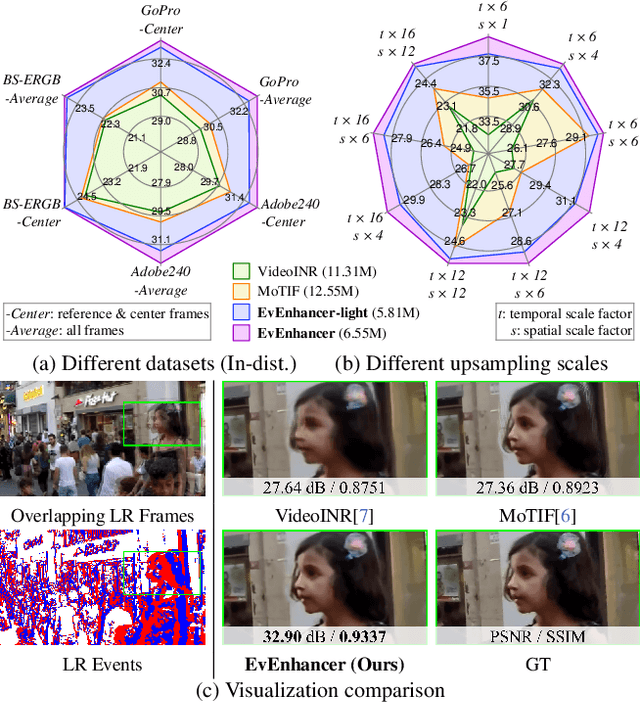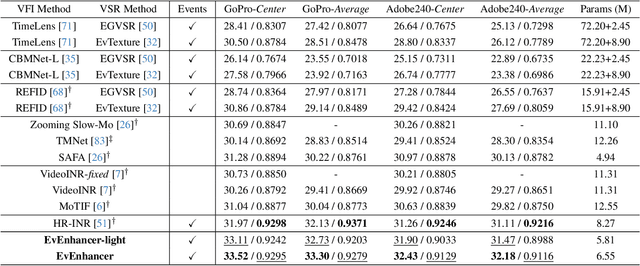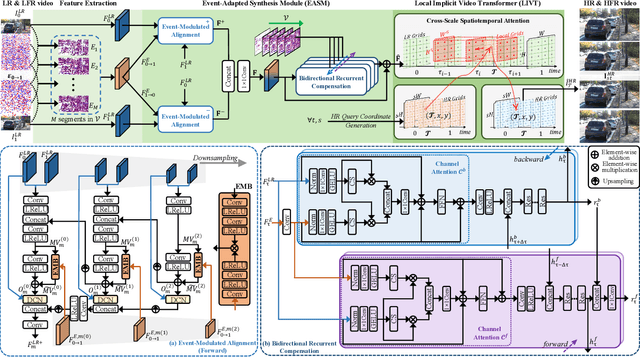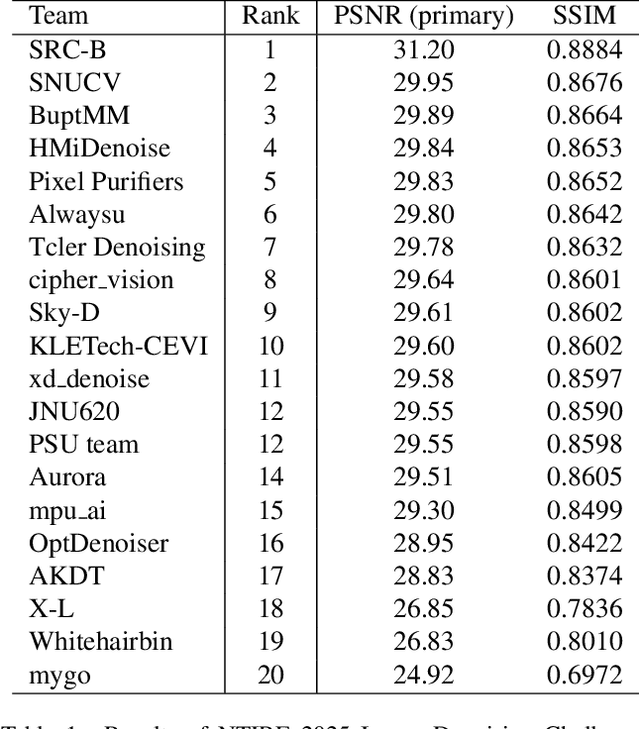Shengeng Tang
SLRTP2025 Sign Language Production Challenge: Methodology, Results, and Future Work
Aug 09, 2025Abstract:Sign Language Production (SLP) is the task of generating sign language video from spoken language inputs. The field has seen a range of innovations over the last few years, with the introduction of deep learning-based approaches providing significant improvements in the realism and naturalness of generated outputs. However, the lack of standardized evaluation metrics for SLP approaches hampers meaningful comparisons across different systems. To address this, we introduce the first Sign Language Production Challenge, held as part of the third SLRTP Workshop at CVPR 2025. The competition's aims are to evaluate architectures that translate from spoken language sentences to a sequence of skeleton poses, known as Text-to-Pose (T2P) translation, over a range of metrics. For our evaluation data, we use the RWTH-PHOENIX-Weather-2014T dataset, a German Sign Language - Deutsche Gebardensprache (DGS) weather broadcast dataset. In addition, we curate a custom hidden test set from a similar domain of discourse. This paper presents the challenge design and the winning methodologies. The challenge attracted 33 participants who submitted 231 solutions, with the top-performing team achieving BLEU-1 scores of 31.40 and DTW-MJE of 0.0574. The winning approach utilized a retrieval-based framework and a pre-trained language model. As part of the workshop, we release a standardized evaluation network, including high-quality skeleton extraction-based keypoints establishing a consistent baseline for the SLP field, which will enable future researchers to compare their work against a broader range of methods.
Motion is the Choreographer: Learning Latent Pose Dynamics for Seamless Sign Language Generation
Aug 06, 2025Abstract:Sign language video generation requires producing natural signing motions with realistic appearances under precise semantic control, yet faces two critical challenges: excessive signer-specific data requirements and poor generalization. We propose a new paradigm for sign language video generation that decouples motion semantics from signer identity through a two-phase synthesis framework. First, we construct a signer-independent multimodal motion lexicon, where each gloss is stored as identity-agnostic pose, gesture, and 3D mesh sequences, requiring only one recording per sign. This compact representation enables our second key innovation: a discrete-to-continuous motion synthesis stage that transforms retrieved gloss sequences into temporally coherent motion trajectories, followed by identity-aware neural rendering to produce photorealistic videos of arbitrary signers. Unlike prior work constrained by signer-specific datasets, our method treats motion as a first-class citizen: the learned latent pose dynamics serve as a portable "choreography layer" that can be visually realized through different human appearances. Extensive experiments demonstrate that disentangling motion from identity is not just viable but advantageous - enabling both high-quality synthesis and unprecedented flexibility in signer personalization.
SplitGaussian: Reconstructing Dynamic Scenes via Visual Geometry Decomposition
Aug 06, 2025Abstract:Reconstructing dynamic 3D scenes from monocular video remains fundamentally challenging due to the need to jointly infer motion, structure, and appearance from limited observations. Existing dynamic scene reconstruction methods based on Gaussian Splatting often entangle static and dynamic elements in a shared representation, leading to motion leakage, geometric distortions, and temporal flickering. We identify that the root cause lies in the coupled modeling of geometry and appearance across time, which hampers both stability and interpretability. To address this, we propose \textbf{SplitGaussian}, a novel framework that explicitly decomposes scene representations into static and dynamic components. By decoupling motion modeling from background geometry and allowing only the dynamic branch to deform over time, our method prevents motion artifacts in static regions while supporting view- and time-dependent appearance refinement. This disentangled design not only enhances temporal consistency and reconstruction fidelity but also accelerates convergence. Extensive experiments demonstrate that SplitGaussian outperforms prior state-of-the-art methods in rendering quality, geometric stability, and motion separation.
StgcDiff: Spatial-Temporal Graph Condition Diffusion for Sign Language Transition Generation
Jun 16, 2025Abstract:Sign language transition generation seeks to convert discrete sign language segments into continuous sign videos by synthesizing smooth transitions. However,most existing methods merely concatenate isolated signs, resulting in poor visual coherence and semantic accuracy in the generated videos. Unlike textual languages,sign language is inherently rich in spatial-temporal cues, making it more complex to model. To address this,we propose StgcDiff, a graph-based conditional diffusion framework that generates smooth transitions between discrete signs by capturing the unique spatial-temporal dependencies of sign language. Specifically, we first train an encoder-decoder architecture to learn a structure-aware representation of spatial-temporal skeleton sequences. Next, we optimize a diffusion denoiser conditioned on the representations learned by the pre-trained encoder, which is tasked with predicting transition frames from noise. Additionally, we design the Sign-GCN module as the key component in our framework, which effectively models the spatial-temporal features. Extensive experiments conducted on the PHOENIX14T, USTC-CSL100,and USTC-SLR500 datasets demonstrate the superior performance of our method.
Towards Fine-Grained Emotion Understanding via Skeleton-Based Micro-Gesture Recognition
Jun 15, 2025Abstract:We present our solution to the MiGA Challenge at IJCAI 2025, which aims to recognize micro-gestures (MGs) from skeleton sequences for the purpose of hidden emotion understanding. MGs are characterized by their subtlety, short duration, and low motion amplitude, making them particularly challenging to model and classify. We adopt PoseC3D as the baseline framework and introduce three key enhancements: (1) a topology-aware skeleton representation specifically designed for the iMiGUE dataset to better capture fine-grained motion patterns; (2) an improved temporal processing strategy that facilitates smoother and more temporally consistent motion modeling; and (3) the incorporation of semantic label embeddings as auxiliary supervision to improve the model generalization. Our method achieves a Top-1 accuracy of 67.01\% on the iMiGUE test set. As a result of these contributions, our approach ranks third on the official MiGA Challenge leaderboard. The source code is available at \href{https://github.com/EGO-False-Sleep/Miga25_track1}{https://github.com/EGO-False-Sleep/Miga25\_track1}.
SignAligner: Harmonizing Complementary Pose Modalities for Coherent Sign Language Generation
Jun 13, 2025Abstract:Sign language generation aims to produce diverse sign representations based on spoken language. However, achieving realistic and naturalistic generation remains a significant challenge due to the complexity of sign language, which encompasses intricate hand gestures, facial expressions, and body movements. In this work, we introduce PHOENIX14T+, an extended version of the widely-used RWTH-PHOENIX-Weather 2014T dataset, featuring three new sign representations: Pose, Hamer and Smplerx. We also propose a novel method, SignAligner, for realistic sign language generation, consisting of three stages: text-driven pose modalities co-generation, online collaborative correction of multimodality, and realistic sign video synthesis. First, by incorporating text semantics, we design a joint sign language generator to simultaneously produce posture coordinates, gesture actions, and body movements. The text encoder, based on a Transformer architecture, extracts semantic features, while a cross-modal attention mechanism integrates these features to generate diverse sign language representations, ensuring accurate mapping and controlling the diversity of modal features. Next, online collaborative correction is introduced to refine the generated pose modalities using a dynamic loss weighting strategy and cross-modal attention, facilitating the complementarity of information across modalities, eliminating spatiotemporal conflicts, and ensuring semantic coherence and action consistency. Finally, the corrected pose modalities are fed into a pre-trained video generation network to produce high-fidelity sign language videos. Extensive experiments demonstrate that SignAligner significantly improves both the accuracy and expressiveness of the generated sign videos.
Wi-CBR: WiFi-based Cross-domain Behavior Recognition via Multimodal Collaborative Awareness
Jun 13, 2025Abstract:WiFi-based human behavior recognition aims to recognize gestures and activities by analyzing wireless signal variations. However, existing methods typically focus on a single type of data, neglecting the interaction and fusion of multiple features. To this end, we propose a novel multimodal collaborative awareness method. By leveraging phase data reflecting changes in dynamic path length and Doppler Shift (DFS) data corresponding to frequency changes related to the speed of gesture movement, we enable efficient interaction and fusion of these features to improve recognition accuracy. Specifically, we first introduce a dual-branch self-attention module to capture spatial-temporal cues within each modality. Then, a group attention mechanism is applied to the concatenated phase and DFS features to mine key group features critical for behavior recognition. Through a gating mechanism, the combined features are further divided into PD-strengthen and PD-weaken branches, optimizing information entropy and promoting cross-modal collaborative awareness. Extensive in-domain and cross-domain experiments on two large publicly available datasets, Widar3.0 and XRF55, demonstrate the superior performance of our method.
EvEnhancer: Empowering Effectiveness, Efficiency and Generalizability for Continuous Space-Time Video Super-Resolution with Events
May 07, 2025



Abstract:Continuous space-time video super-resolution (C-STVSR) endeavors to upscale videos simultaneously at arbitrary spatial and temporal scales, which has recently garnered increasing interest. However, prevailing methods struggle to yield satisfactory videos at out-of-distribution spatial and temporal scales. On the other hand, event streams characterized by high temporal resolution and high dynamic range, exhibit compelling promise in vision tasks. This paper presents EvEnhancer, an innovative approach that marries the unique advantages of event streams to elevate effectiveness, efficiency, and generalizability for C-STVSR. Our approach hinges on two pivotal components: 1) Event-adapted synthesis capitalizes on the spatiotemporal correlations between frames and events to discern and learn long-term motion trajectories, enabling the adaptive interpolation and fusion of informative spatiotemporal features; 2) Local implicit video transformer integrates local implicit video neural function with cross-scale spatiotemporal attention to learn continuous video representations utilized to generate plausible videos at arbitrary resolutions and frame rates. Experiments show that EvEnhancer achieves superiority on synthetic and real-world datasets and preferable generalizability on out-of-distribution scales against state-of-the-art methods. Code is available at https://github.com/W-Shuoyan/EvEnhancer.
The Tenth NTIRE 2025 Image Denoising Challenge Report
Apr 16, 2025



Abstract:This paper presents an overview of the NTIRE 2025 Image Denoising Challenge ({\sigma} = 50), highlighting the proposed methodologies and corresponding results. The primary objective is to develop a network architecture capable of achieving high-quality denoising performance, quantitatively evaluated using PSNR, without constraints on computational complexity or model size. The task assumes independent additive white Gaussian noise (AWGN) with a fixed noise level of 50. A total of 290 participants registered for the challenge, with 20 teams successfully submitting valid results, providing insights into the current state-of-the-art in image denoising.
Text-Driven Diffusion Model for Sign Language Production
Mar 20, 2025Abstract:We introduce the hfut-lmc team's solution to the SLRTP Sign Production Challenge. The challenge aims to generate semantically aligned sign language pose sequences from text inputs. To this end, we propose a Text-driven Diffusion Model (TDM) framework. During the training phase, TDM utilizes an encoder to encode text sequences and incorporates them into the diffusion model as conditional input to generate sign pose sequences. To guarantee the high quality and accuracy of the generated pose sequences, we utilize two key loss functions. The joint loss function L_{joint} is used to precisely measure and minimize the differences between the joint positions of the generated pose sequences and those of the ground truth. Similarly, the bone orientation loss function L_{bone} is instrumental in ensuring that the orientation of the bones in the generated poses aligns with the actual, correct orientations. In the inference stage, the TDM framework takes on a different yet equally important task. It starts with noisy sequences and, under the strict constraints of the text conditions, gradually refines and generates semantically consistent sign language pose sequences. Our carefully designed framework performs well on the sign language production task, and our solution achieves a BLEU-1 score of 20.17, placing second in the challenge.
 Add to Chrome
Add to Chrome Add to Firefox
Add to Firefox Add to Edge
Add to Edge